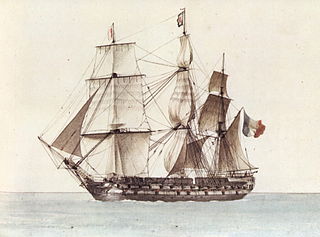
Topaze was a Gloire-class 44-gun frigate of the French Navy. The British captured her in 1809 and she then served with the Royal Navy under the name Jewel, and later Alcmene until she was broken up in 1816.

Borée was a Téméraire class 74-gun ship of the line of the French Navy.
Jean-François Lemaresquier was a French naval officer.
Jacques Pinsum was a French Navy officer.
Entreprenant was a French ship, the third under the same name and with the same captain in the period 1807–1810. She served in the East Indies until the British captured her in 1810 and then had her broken up as unfit for further service.
Jean-Baptiste-Augustin Rousseau was a French naval officer.

Melpomène was a 44-gun frigate of the French Navy, designed by Sané. She was launched in 1812. In 1815 HMS Rivoli captured her. The Royal Navy never commissioned Melpomène and in 1821 sold her for breaking up.
Vincent-Marie Moulac was a French naval officer and privateer.
Créole was a 40-gun frigate of the French Navy, a one-off design by Jacques-Augustin Lamothe. The French Navy loaned her to a privateer in 1797. Later, she served in the Brest squadron, took part in Ganteaume's expeditions of 1801 to Egypt, and was involved in the French acquisition of Santo Domingo and briefly detained Toussaint Louverture before he was brought to France. The 74-gun ships HMS Vanguard and HMS Cumberland captured her in Santo Domingo on 30 June 1803. The Royal Navy took her into service but she foundered soon afterwards during an attempt to sail to Britain; her crew were rescued.
Jean-Michel Mahé was a French Navy officer.

Louis-Charles-Auguste Delamarre, vicomte de Lamellerie was a French Navy officer and nobleman. He is buried in Pere Lachaise cemetery, in Paris.
Jean-Joseph Hubert was a French Navy officer and captain.
Jean-Baptiste Joseph René Poulain was a French Navy officer.
Amand Leduc was a French sailor and Navy officer of the First French Empire.
Courageuse was a 12-pounder Concorde class frigate of the French Navy. She was launched in 1778. The British captured her in 1799 and thereafter used her as a receiving ship or prison hulk at Malta before breaking her up in 1802.
Salamine was originally the Spanish Navy's Infante 18-gun brig, built in 1787 at Cadiz. The French Navy captured her at Toulon in December 1793 and recommissioned her; they renamed her on 10 May 1798 as Salamine, for the battle of Salamis. On 18 June 1799, HMS Emerald captured her and she was brought into Royal Navy service as HMS Salamine. She served briefly in the Mediterranean, where she captured two French privateers and several merchant vessels before the Royal Navy sold her at Malta in 1802, after the Treaty of Amiens ended the war with France.
HMS Plumper was a later Archer-class gun-brig of the Royal Navy, launched in 1804. The French captured her in 1805 and took her into their Navy under her existing name. Between 1814 and 1815 her name alternated between Plumper and Argus, finally settling on Argus. As Argus she sailed to Senegal in 1816 in company with Méduse, whose shipwreck gave rise to a famous painting. In 1818 Argus was assigned to colonial service. She was condemned in October 1822 at Saint-Louis, Senegal, and struck in 1827.

Départment des Landes was a corvette of the French Navy, launched in 1804. She was damaged in 1814 and subsequently decommissioned. She was finally broken up around 1829-30.
The Loire-class flûte was a French Navy class of two 20-gun flûtes that Louis, Antoine, and Marhurin Crucy, Basse Indre, built to a design by François-Louis Etesse, and under a contract dated 5 November 1802.
HMS Elizabeth was a French privateer schooner that the Royal Navy captured in 1805 and took into service under her existing name. She participated in an engagement and a campaign that earned her crews clasps to the Naval General Service Medal. She was lost with all hands in 1814 when she capsized in the West Indies.



